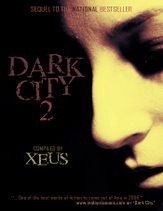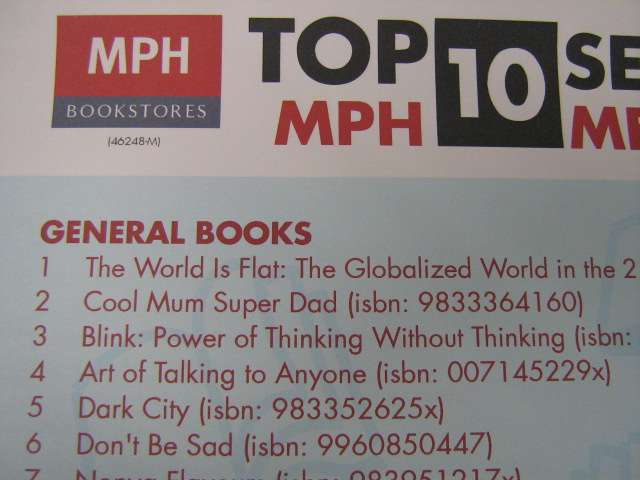Chick lit
Haven't blogged in a long time, I know - too much travelling, too tired. Doing this right now in Schilpol Airport while waiting for my connection to Spain. This article is published in the Star today and involved me interviewing Cecelia Ahern's publishers. Dunno if the sidebar showed up.
http://thestar.com.my/lifestyle/story.asp?file=/2008/6/29/lifebookshelf/21585761&sec=lifebookshelf
Happy lite lit
By EUDORA LYNN
In place of our monthly focus on literary titles, we turn our attention to what is, according to our writer, a sorely misunderstood genre: chick lit. Trashy and vapid? No, no, no, insists the passionate fan.
THERE are plenty of misconceptions about chick lit, such as that it’s “fluffy, trashy, shallow, mind-numbing, formulaic” and “something only a vapid woman can enjoy”. (Oh dear, that just about confirms my husband’s suspicions about me.)
Chick lit, for those of you who haven’t tuned into the world since 1992, is fiction written by women for women.
These books differ from other women’s books by almost always being humorous, appearing in bright, fluffy covers, usually featuring funny, fluffy caricatures, and being written, almost uniformly, in an extremely personal style, as though the reader is a gnat hovering around the female protagonist’s flat, eavesdropping on her conversations and life.
Chick lit is believed to have originated in the mid-1990s with Adele Lang’s Confession of a Sociopathic Social Climber. That kind of intimate, “I’m confiding in you, dear reader” sort of writing skyrocketed in popularity with Helen Fielding’s Bridget Jones’s Diary – and, with money to be made, everyone started jumping on board, of course.
Chick lit was also originally written for single working women in their 20s or 30s, but has since expanded into sub-genres that include mum lit (featuring the perils of young mums and mums-to-be), glamour lit (of glamorous social climbers and heiresses), mystery lit (think Desperate Housewives), wedding lit (self-explanatory) and fantasy lit (where something otherworldly happens to the protagonist, such as tripping into a different world – Cecelia Ahern’s There’s No Place Like Here – or different time zone – Sophie Kinsella’s Remember Me?)
There’s another burgeoning sub-genre called multi-cultural lit that can be further divided into Indian, Latina and other Asian. In these books, perky ethnic women try to carve out a life for themselves in a Western land, such as in books written by Nisha Minhas on Indian women living in Britain who are choked by cultural traditions and yet still manage to land spectacularly gorgeous Caucasian men. (Who are also very good in bed and initially have white girlfriends whom they will dump for said ethnic heroine.)
Phew, bet you never knew this was such a complicated genre, right?
What makes chick lit so enduringly popular is that there’s something for Everywoman to identify with. Chick lit heroines (tick characteristics you see in yourself):
1. Are usually single (even if you’re married now, you have once been single and kind of desperate, right?).
2. Are usually stuck in a job she doesn’t want to be in.
3. Are usually stuck with a boss she doesn’t want to be with.
4. Are usually fairly attractive but not stunningly so, and usually possessed of physical attributes she hates and totally wants to change (being overweight, snaggle haired, button nosed).
5. Have a gaggle of roommates/girlfriends/gay guy friends who are extremely supportive, promiscuous, and chatty.
Chick lit is also not exclusively romance, although a guy seems to trip into 99% of it since we women can’t seem to exist without men (I’m rolling my eyes, here).
Male love interests in chick lit are also attractive but the majority are also not panty-meltingly, heart-stoppingly so. If there are any superlatively handsome male characters, they usually turn out to be cads.
Chick lit protagonists also have a lot of other stuff going on in their lives, such as juggling careers, dealing with bad habits like being a chocoholic or a shopaholic, balancing their bankbooks, cooking bad food, and basically going through the exhaustive process of finding themselves. It’s Sex and the City, only with a lot less sex.
In other words, the writers of chick lit seem to be saying – to me, anyway – “This is you. You can totally see yourself in this. We are writing you for you.” (And also to make a lot of money.)
Chick lit stories end well, usually with the heroine getting the job of her dreams and landing her true love, a fact that also contributes to the genre’s appeal.
At the end of the day, when you pick up chick lit, you want a happy, humorous story you can laugh over and see yourself in (with chagrin), you want to find solutions to trials and tribulations you yourself have been through, and you want to know that if a fictitious someone else can have a happy ending, you can have it too.
And that’s all we really want in our lives, happy endings.
And these are a few Q and As from Penguin which I did an email interview.
1. What do you look for in the writing when you decide to publish something in the genre of chick lit?
We look for lots of things but most importantly it is making a connection in a fun way with the reader using the themes of love romance
and fidelity in relationships. The tone should be light and highly readable and a touch of devil may care mischief always goes down a treat.
2. On average, how much does a chick lit title sell?
Our bestselling authors sell over 100 000 copies
3. What is your biggest chick lit title? How many copies has it sold?
The answer is SUDDENLY SINGLE which has done 320k since 1999. Best since then is YOURS FAITHFULLY at 272k. Jill Mansell is usually at about the 200k level.


